BSBWOR404 Nursing: Developing Priorities, Plans, and Performance
VerifiedAdded on 2023/06/10
|7
|1247
|414
Homework Assignment
AI Summary
This assignment provides answers to questions related to nursing practice, focusing on performance evaluation, professional development, and work planning. It covers topics such as software applications for scheduling nursing shifts, techniques for preparing personal and professional plans, methods for identifying and prioritizing learning needs, professional development opportunities for enrolled nurses, methods for eliciting and analyzing feedback, and detailed explanations of methods used to evaluate performance in providing nursing care. The assignment references NANDA guidelines and emphasizes the importance of self-evaluation, feedback from colleagues and patients, and continuous professional development in improving nursing practice. Desklib offers a wide range of solved assignments and study resources for students.
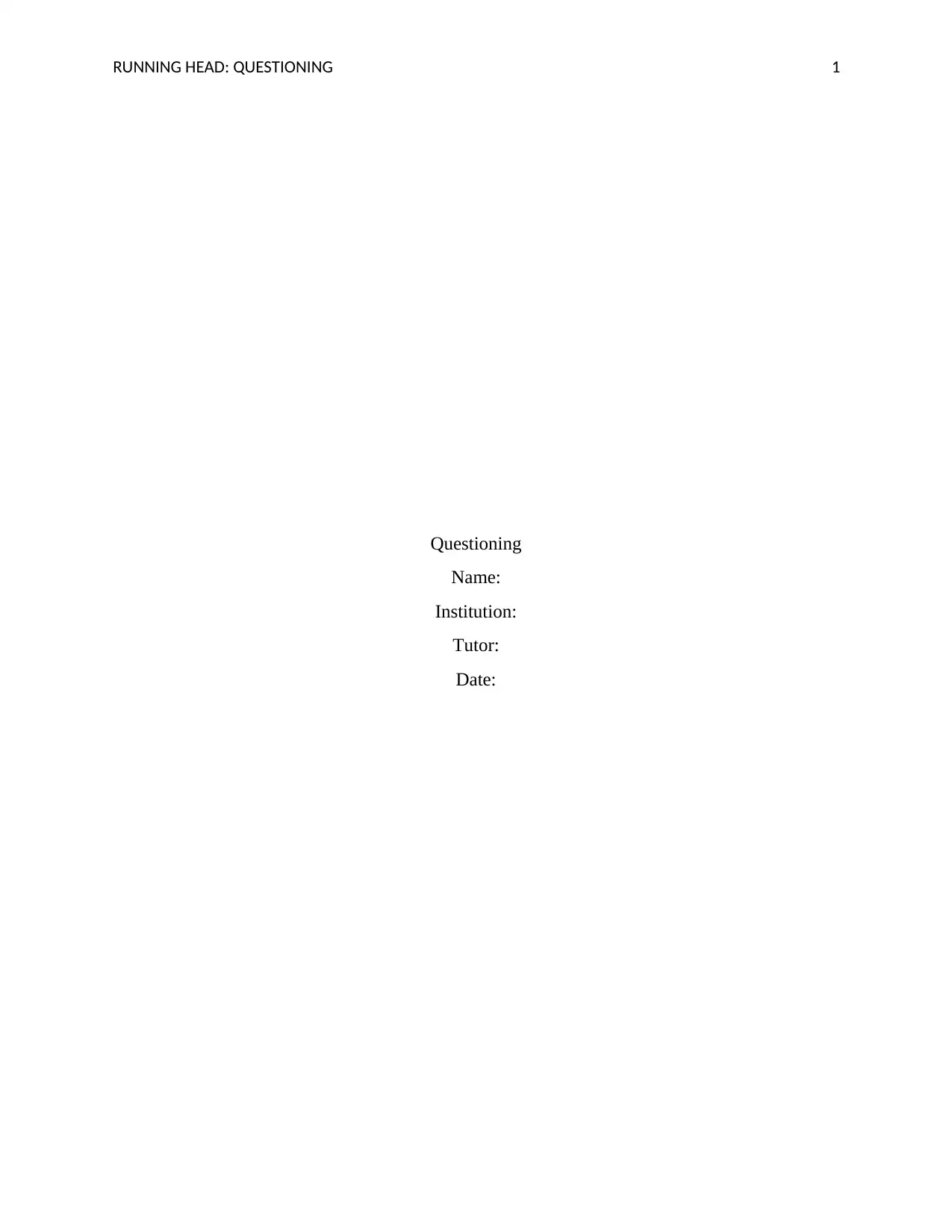
RUNNING HEAD: QUESTIONING 1
Questioning
Name:
Institution:
Tutor:
Date:
Questioning
Name:
Institution:
Tutor:
Date:
Paraphrase This Document
Need a fresh take? Get an instant paraphrase of this document with our AI Paraphraser
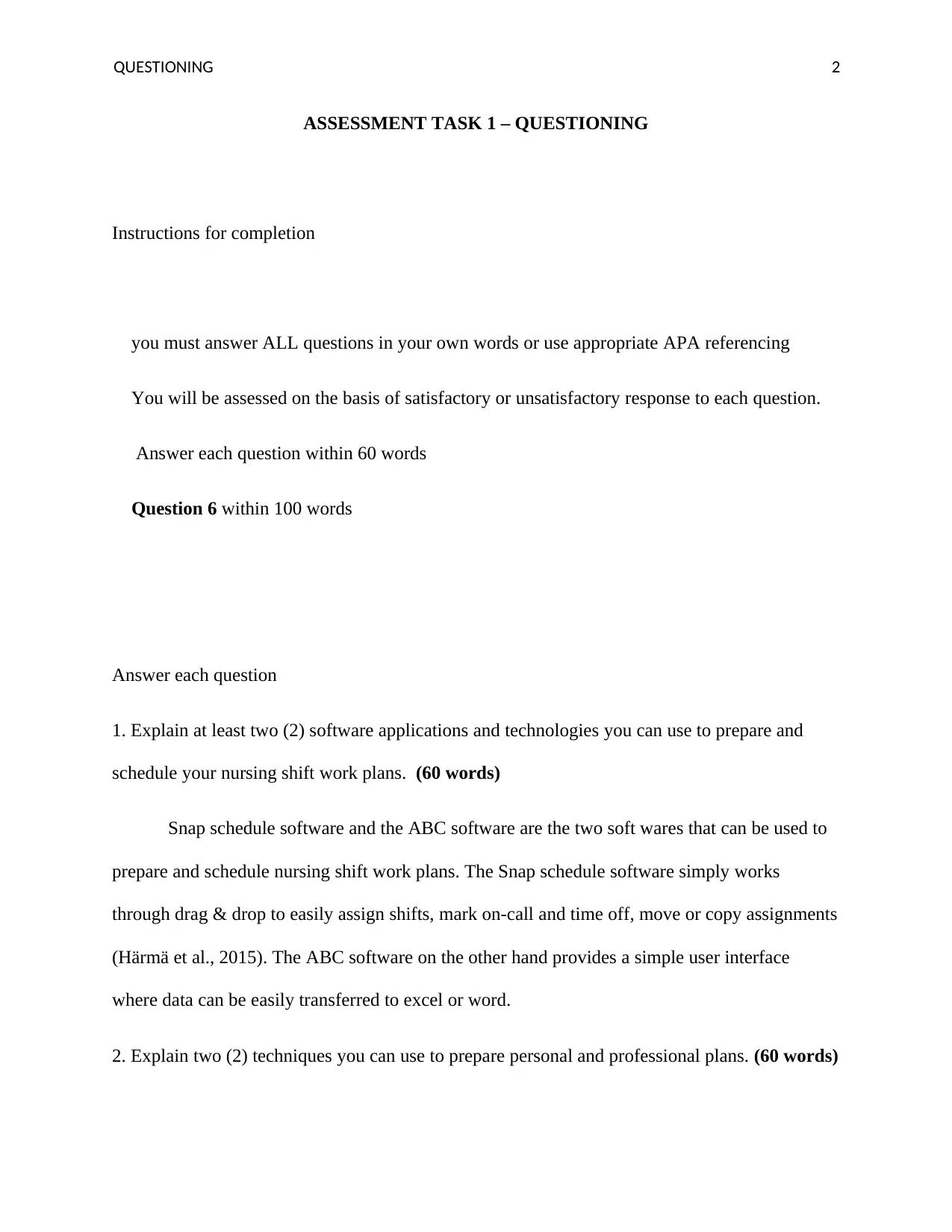
QUESTIONING 2
ASSESSMENT TASK 1 – QUESTIONING
Instructions for completion
you must answer ALL questions in your own words or use appropriate APA referencing
You will be assessed on the basis of satisfactory or unsatisfactory response to each question.
Answer each question within 60 words
Question 6 within 100 words
Answer each question
1. Explain at least two (2) software applications and technologies you can use to prepare and
schedule your nursing shift work plans. (60 words)
Snap schedule software and the ABC software are the two soft wares that can be used to
prepare and schedule nursing shift work plans. The Snap schedule software simply works
through drag & drop to easily assign shifts, mark on-call and time off, move or copy assignments
(Härmä et al., 2015). The ABC software on the other hand provides a simple user interface
where data can be easily transferred to excel or word.
2. Explain two (2) techniques you can use to prepare personal and professional plans. (60 words)
ASSESSMENT TASK 1 – QUESTIONING
Instructions for completion
you must answer ALL questions in your own words or use appropriate APA referencing
You will be assessed on the basis of satisfactory or unsatisfactory response to each question.
Answer each question within 60 words
Question 6 within 100 words
Answer each question
1. Explain at least two (2) software applications and technologies you can use to prepare and
schedule your nursing shift work plans. (60 words)
Snap schedule software and the ABC software are the two soft wares that can be used to
prepare and schedule nursing shift work plans. The Snap schedule software simply works
through drag & drop to easily assign shifts, mark on-call and time off, move or copy assignments
(Härmä et al., 2015). The ABC software on the other hand provides a simple user interface
where data can be easily transferred to excel or word.
2. Explain two (2) techniques you can use to prepare personal and professional plans. (60 words)
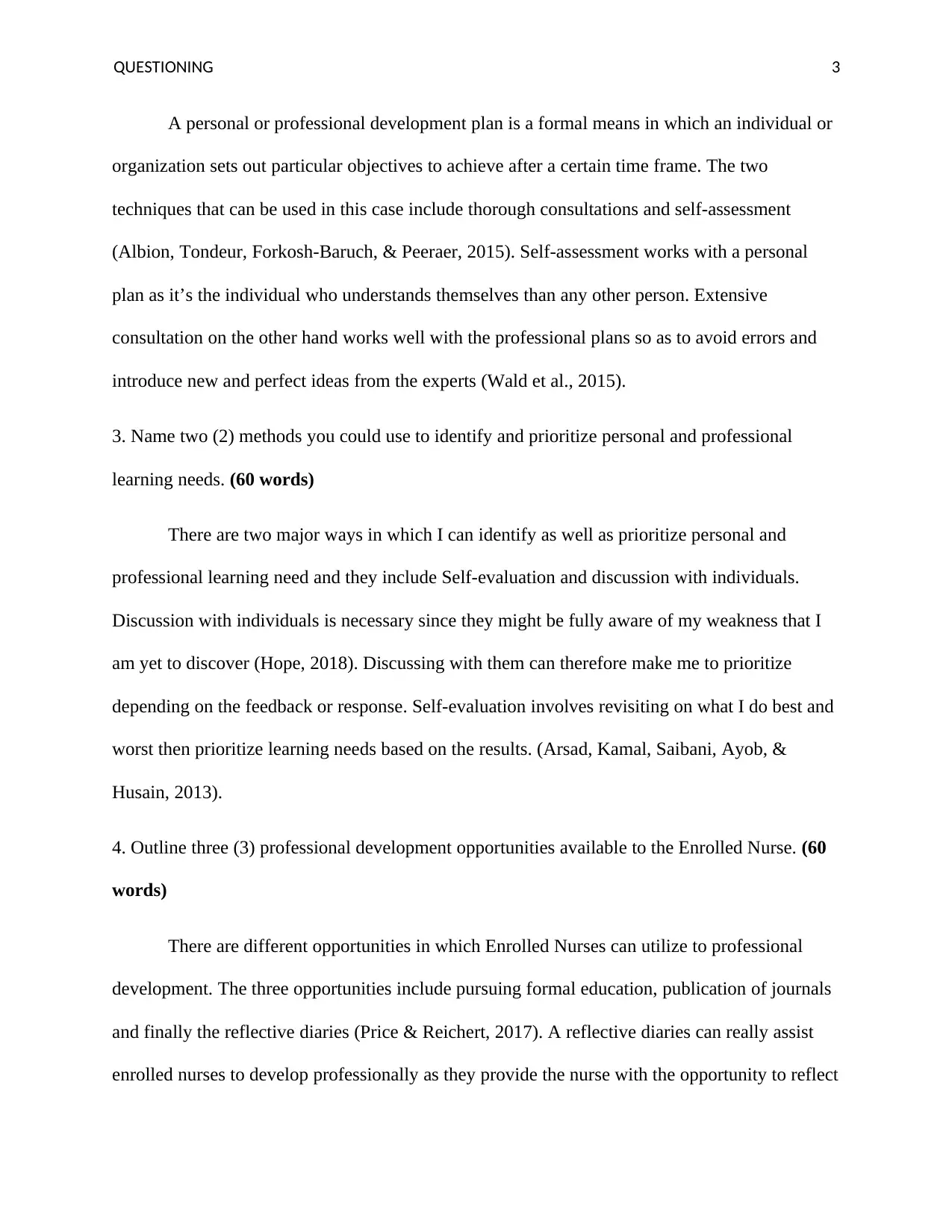
QUESTIONING 3
A personal or professional development plan is a formal means in which an individual or
organization sets out particular objectives to achieve after a certain time frame. The two
techniques that can be used in this case include thorough consultations and self-assessment
(Albion, Tondeur, Forkosh-Baruch, & Peeraer, 2015). Self-assessment works with a personal
plan as it’s the individual who understands themselves than any other person. Extensive
consultation on the other hand works well with the professional plans so as to avoid errors and
introduce new and perfect ideas from the experts (Wald et al., 2015).
3. Name two (2) methods you could use to identify and prioritize personal and professional
learning needs. (60 words)
There are two major ways in which I can identify as well as prioritize personal and
professional learning need and they include Self-evaluation and discussion with individuals.
Discussion with individuals is necessary since they might be fully aware of my weakness that I
am yet to discover (Hope, 2018). Discussing with them can therefore make me to prioritize
depending on the feedback or response. Self-evaluation involves revisiting on what I do best and
worst then prioritize learning needs based on the results. (Arsad, Kamal, Saibani, Ayob, &
Husain, 2013).
4. Outline three (3) professional development opportunities available to the Enrolled Nurse. (60
words)
There are different opportunities in which Enrolled Nurses can utilize to professional
development. The three opportunities include pursuing formal education, publication of journals
and finally the reflective diaries (Price & Reichert, 2017). A reflective diaries can really assist
enrolled nurses to develop professionally as they provide the nurse with the opportunity to reflect
A personal or professional development plan is a formal means in which an individual or
organization sets out particular objectives to achieve after a certain time frame. The two
techniques that can be used in this case include thorough consultations and self-assessment
(Albion, Tondeur, Forkosh-Baruch, & Peeraer, 2015). Self-assessment works with a personal
plan as it’s the individual who understands themselves than any other person. Extensive
consultation on the other hand works well with the professional plans so as to avoid errors and
introduce new and perfect ideas from the experts (Wald et al., 2015).
3. Name two (2) methods you could use to identify and prioritize personal and professional
learning needs. (60 words)
There are two major ways in which I can identify as well as prioritize personal and
professional learning need and they include Self-evaluation and discussion with individuals.
Discussion with individuals is necessary since they might be fully aware of my weakness that I
am yet to discover (Hope, 2018). Discussing with them can therefore make me to prioritize
depending on the feedback or response. Self-evaluation involves revisiting on what I do best and
worst then prioritize learning needs based on the results. (Arsad, Kamal, Saibani, Ayob, &
Husain, 2013).
4. Outline three (3) professional development opportunities available to the Enrolled Nurse. (60
words)
There are different opportunities in which Enrolled Nurses can utilize to professional
development. The three opportunities include pursuing formal education, publication of journals
and finally the reflective diaries (Price & Reichert, 2017). A reflective diaries can really assist
enrolled nurses to develop professionally as they provide the nurse with the opportunity to reflect
⊘ This is a preview!⊘
Do you want full access?
Subscribe today to unlock all pages.

Trusted by 1+ million students worldwide
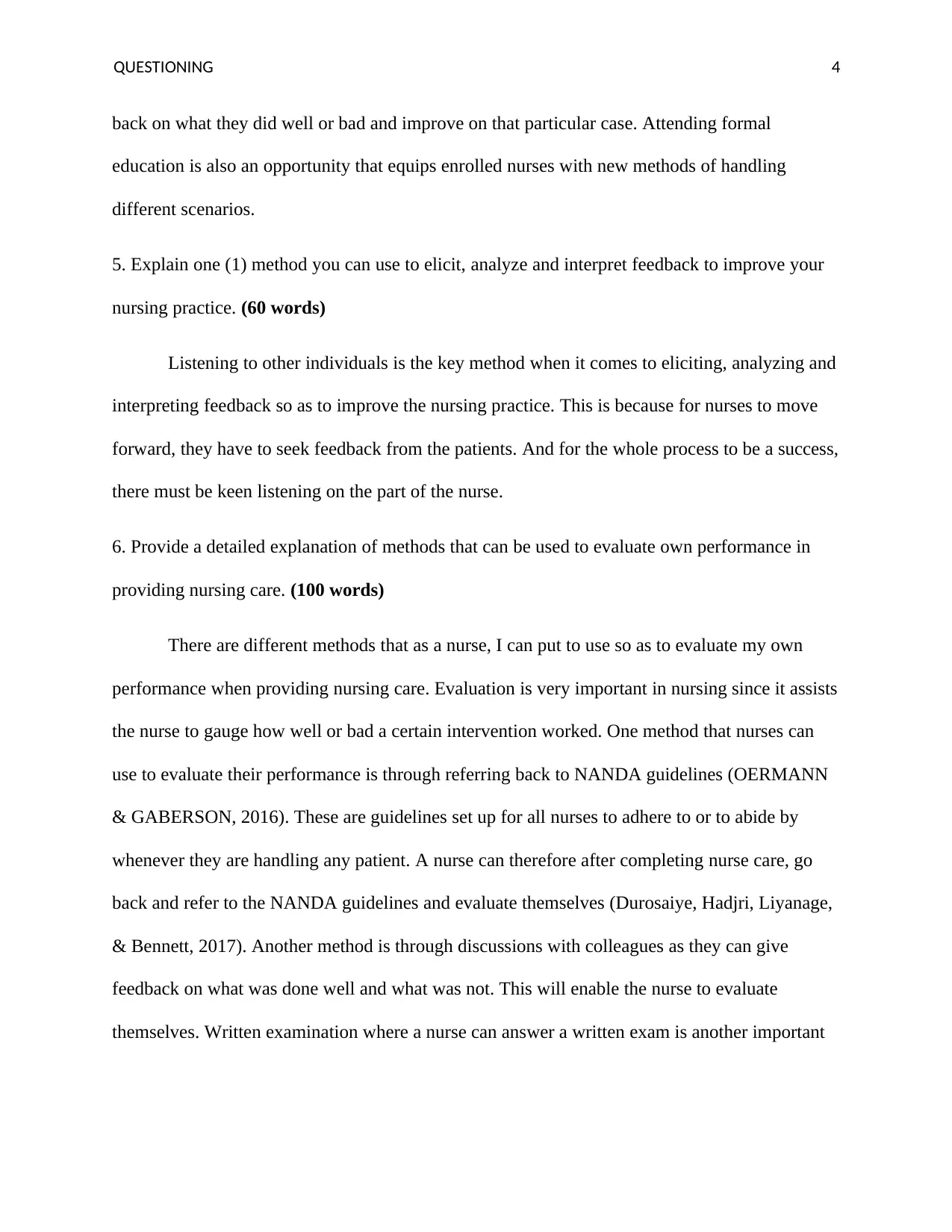
QUESTIONING 4
back on what they did well or bad and improve on that particular case. Attending formal
education is also an opportunity that equips enrolled nurses with new methods of handling
different scenarios.
5. Explain one (1) method you can use to elicit, analyze and interpret feedback to improve your
nursing practice. (60 words)
Listening to other individuals is the key method when it comes to eliciting, analyzing and
interpreting feedback so as to improve the nursing practice. This is because for nurses to move
forward, they have to seek feedback from the patients. And for the whole process to be a success,
there must be keen listening on the part of the nurse.
6. Provide a detailed explanation of methods that can be used to evaluate own performance in
providing nursing care. (100 words)
There are different methods that as a nurse, I can put to use so as to evaluate my own
performance when providing nursing care. Evaluation is very important in nursing since it assists
the nurse to gauge how well or bad a certain intervention worked. One method that nurses can
use to evaluate their performance is through referring back to NANDA guidelines (OERMANN
& GABERSON, 2016). These are guidelines set up for all nurses to adhere to or to abide by
whenever they are handling any patient. A nurse can therefore after completing nurse care, go
back and refer to the NANDA guidelines and evaluate themselves (Durosaiye, Hadjri, Liyanage,
& Bennett, 2017). Another method is through discussions with colleagues as they can give
feedback on what was done well and what was not. This will enable the nurse to evaluate
themselves. Written examination where a nurse can answer a written exam is another important
back on what they did well or bad and improve on that particular case. Attending formal
education is also an opportunity that equips enrolled nurses with new methods of handling
different scenarios.
5. Explain one (1) method you can use to elicit, analyze and interpret feedback to improve your
nursing practice. (60 words)
Listening to other individuals is the key method when it comes to eliciting, analyzing and
interpreting feedback so as to improve the nursing practice. This is because for nurses to move
forward, they have to seek feedback from the patients. And for the whole process to be a success,
there must be keen listening on the part of the nurse.
6. Provide a detailed explanation of methods that can be used to evaluate own performance in
providing nursing care. (100 words)
There are different methods that as a nurse, I can put to use so as to evaluate my own
performance when providing nursing care. Evaluation is very important in nursing since it assists
the nurse to gauge how well or bad a certain intervention worked. One method that nurses can
use to evaluate their performance is through referring back to NANDA guidelines (OERMANN
& GABERSON, 2016). These are guidelines set up for all nurses to adhere to or to abide by
whenever they are handling any patient. A nurse can therefore after completing nurse care, go
back and refer to the NANDA guidelines and evaluate themselves (Durosaiye, Hadjri, Liyanage,
& Bennett, 2017). Another method is through discussions with colleagues as they can give
feedback on what was done well and what was not. This will enable the nurse to evaluate
themselves. Written examination where a nurse can answer a written exam is another important
Paraphrase This Document
Need a fresh take? Get an instant paraphrase of this document with our AI Paraphraser
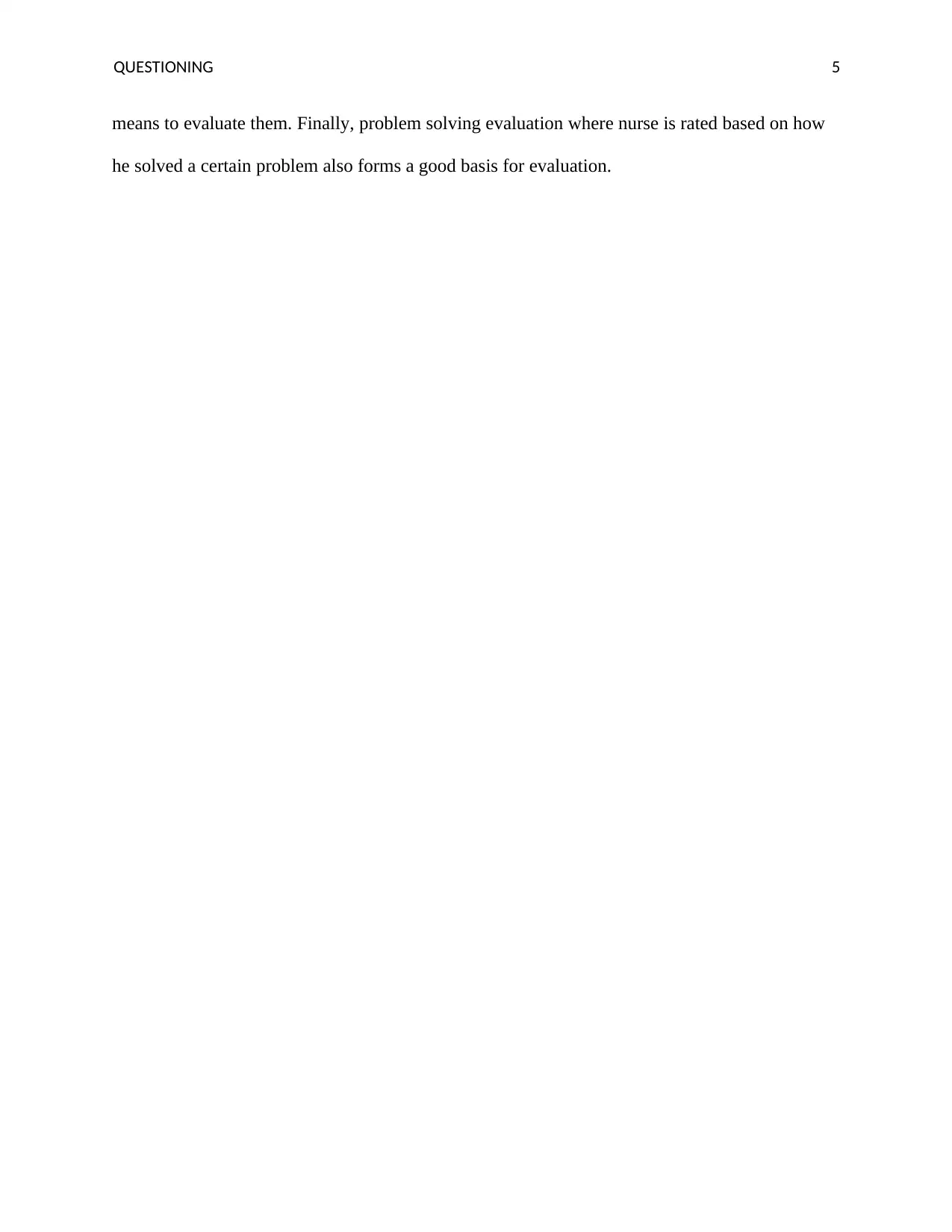
QUESTIONING 5
means to evaluate them. Finally, problem solving evaluation where nurse is rated based on how
he solved a certain problem also forms a good basis for evaluation.
means to evaluate them. Finally, problem solving evaluation where nurse is rated based on how
he solved a certain problem also forms a good basis for evaluation.
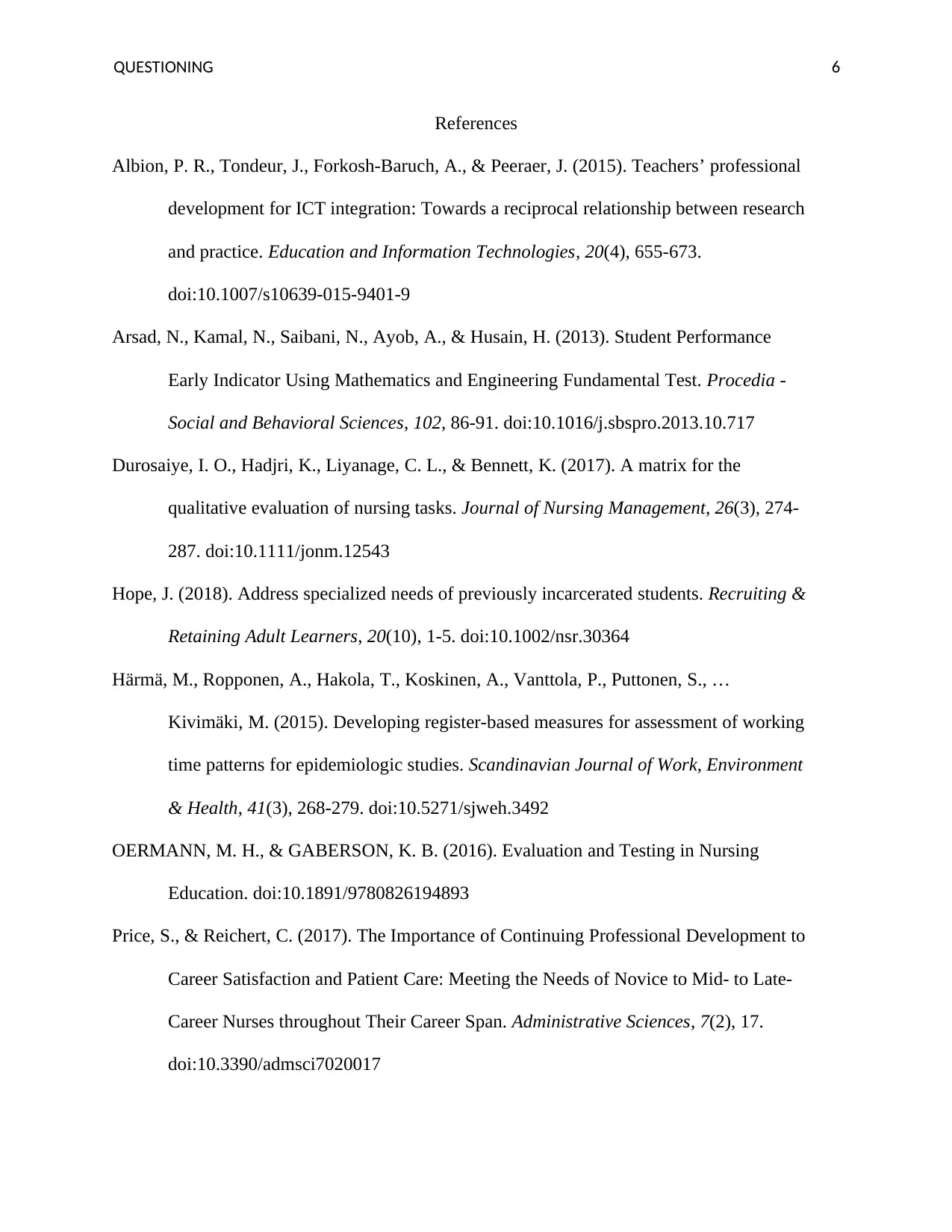
QUESTIONING 6
References
Albion, P. R., Tondeur, J., Forkosh-Baruch, A., & Peeraer, J. (2015). Teachers’ professional
development for ICT integration: Towards a reciprocal relationship between research
and practice. Education and Information Technologies, 20(4), 655-673.
doi:10.1007/s10639-015-9401-9
Arsad, N., Kamal, N., Saibani, N., Ayob, A., & Husain, H. (2013). Student Performance
Early Indicator Using Mathematics and Engineering Fundamental Test. Procedia -
Social and Behavioral Sciences, 102, 86-91. doi:10.1016/j.sbspro.2013.10.717
Durosaiye, I. O., Hadjri, K., Liyanage, C. L., & Bennett, K. (2017). A matrix for the
qualitative evaluation of nursing tasks. Journal of Nursing Management, 26(3), 274-
287. doi:10.1111/jonm.12543
Hope, J. (2018). Address specialized needs of previously incarcerated students. Recruiting &
Retaining Adult Learners, 20(10), 1-5. doi:10.1002/nsr.30364
Härmä, M., Ropponen, A., Hakola, T., Koskinen, A., Vanttola, P., Puttonen, S., …
Kivimäki, M. (2015). Developing register-based measures for assessment of working
time patterns for epidemiologic studies. Scandinavian Journal of Work, Environment
& Health, 41(3), 268-279. doi:10.5271/sjweh.3492
OERMANN, M. H., & GABERSON, K. B. (2016). Evaluation and Testing in Nursing
Education. doi:10.1891/9780826194893
Price, S., & Reichert, C. (2017). The Importance of Continuing Professional Development to
Career Satisfaction and Patient Care: Meeting the Needs of Novice to Mid- to Late-
Career Nurses throughout Their Career Span. Administrative Sciences, 7(2), 17.
doi:10.3390/admsci7020017
References
Albion, P. R., Tondeur, J., Forkosh-Baruch, A., & Peeraer, J. (2015). Teachers’ professional
development for ICT integration: Towards a reciprocal relationship between research
and practice. Education and Information Technologies, 20(4), 655-673.
doi:10.1007/s10639-015-9401-9
Arsad, N., Kamal, N., Saibani, N., Ayob, A., & Husain, H. (2013). Student Performance
Early Indicator Using Mathematics and Engineering Fundamental Test. Procedia -
Social and Behavioral Sciences, 102, 86-91. doi:10.1016/j.sbspro.2013.10.717
Durosaiye, I. O., Hadjri, K., Liyanage, C. L., & Bennett, K. (2017). A matrix for the
qualitative evaluation of nursing tasks. Journal of Nursing Management, 26(3), 274-
287. doi:10.1111/jonm.12543
Hope, J. (2018). Address specialized needs of previously incarcerated students. Recruiting &
Retaining Adult Learners, 20(10), 1-5. doi:10.1002/nsr.30364
Härmä, M., Ropponen, A., Hakola, T., Koskinen, A., Vanttola, P., Puttonen, S., …
Kivimäki, M. (2015). Developing register-based measures for assessment of working
time patterns for epidemiologic studies. Scandinavian Journal of Work, Environment
& Health, 41(3), 268-279. doi:10.5271/sjweh.3492
OERMANN, M. H., & GABERSON, K. B. (2016). Evaluation and Testing in Nursing
Education. doi:10.1891/9780826194893
Price, S., & Reichert, C. (2017). The Importance of Continuing Professional Development to
Career Satisfaction and Patient Care: Meeting the Needs of Novice to Mid- to Late-
Career Nurses throughout Their Career Span. Administrative Sciences, 7(2), 17.
doi:10.3390/admsci7020017
⊘ This is a preview!⊘
Do you want full access?
Subscribe today to unlock all pages.

Trusted by 1+ million students worldwide
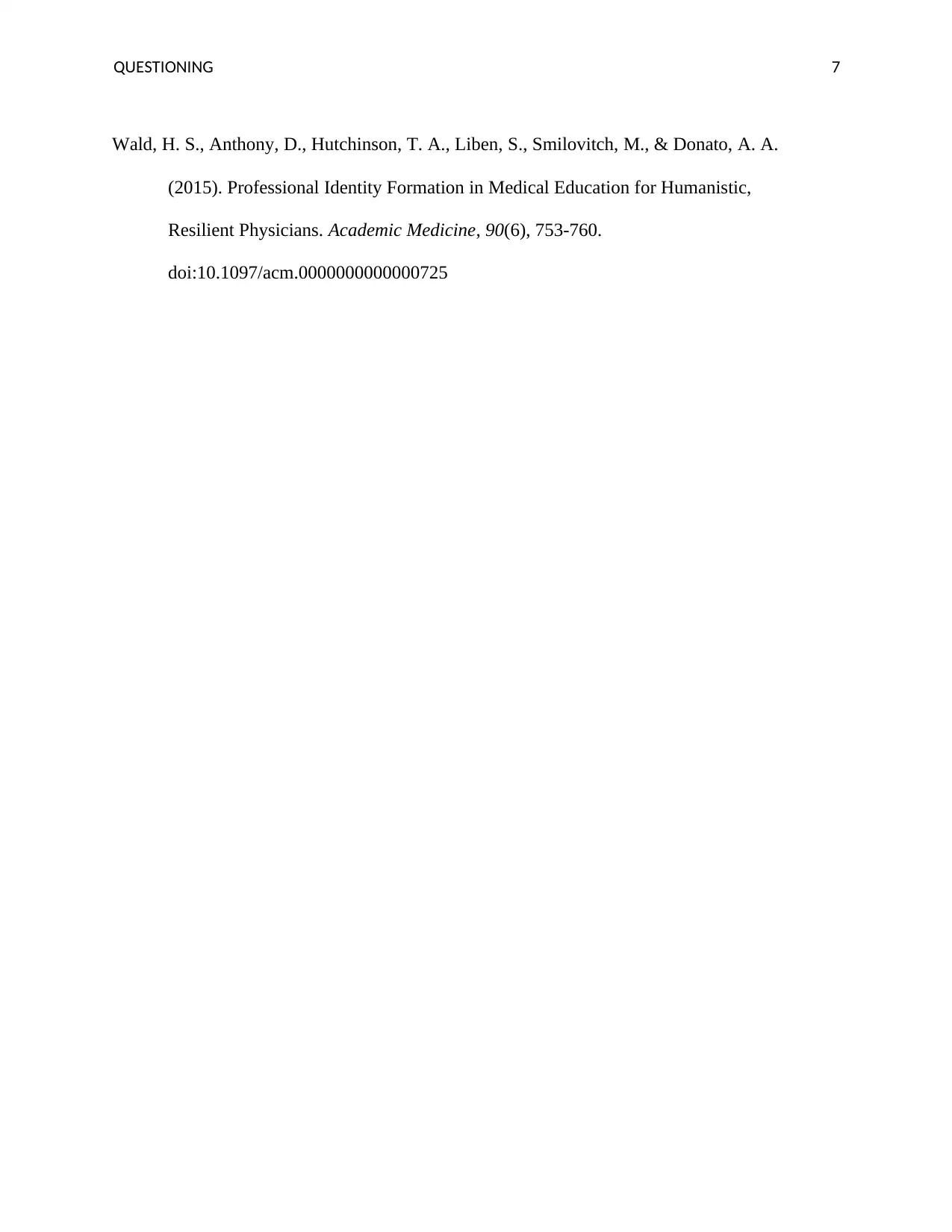
QUESTIONING 7
Wald, H. S., Anthony, D., Hutchinson, T. A., Liben, S., Smilovitch, M., & Donato, A. A.
(2015). Professional Identity Formation in Medical Education for Humanistic,
Resilient Physicians. Academic Medicine, 90(6), 753-760.
doi:10.1097/acm.0000000000000725
Wald, H. S., Anthony, D., Hutchinson, T. A., Liben, S., Smilovitch, M., & Donato, A. A.
(2015). Professional Identity Formation in Medical Education for Humanistic,
Resilient Physicians. Academic Medicine, 90(6), 753-760.
doi:10.1097/acm.0000000000000725
1 out of 7
Related Documents
Your All-in-One AI-Powered Toolkit for Academic Success.
+13062052269
info@desklib.com
Available 24*7 on WhatsApp / Email
![[object Object]](/_next/static/media/star-bottom.7253800d.svg)
Unlock your academic potential
Copyright © 2020–2025 A2Z Services. All Rights Reserved. Developed and managed by ZUCOL.





